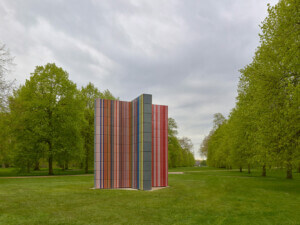The art exhibition Documenta has been staged every five years in Kassel, Germany since 1955. The first Documenta was labeled “a museum for 100 days” and featured work from the famous 1937 degenerate art show staged by the Nazis. It was an example of Germany coming to terms with its troubled past and it created a reputation that Documenta would take risks and comment critically on contemporary issues in the art world and society.
This year’s quinquennial event is staged in public spaces, museums, and squares all over the German city and for the first time in Athens, Greece. The joint Kassel/Athens staging is perhaps a German gesture of goodwill between the two European Union nations that have had a contentious political relationship since the 2016 Greek debt crises. But the curatorial team behind Documenta 14, lead by artistic director Adam Szymczyk, makes the case for Greece as the birthplace of democratic ideals and thus an important partner in 2017. This dual exhibition strategy was created (at the height of the Greek economic crises) so one can see “how problematic things are at the moment, and how much worse they may soon become—though not, naturally, to simply induce passive spectatorship,” said Szymczyk in the exhibition catalogue. The works in Kassel are installed all over the town; museums, cinemas, schools, parks, paths, clubs, and shops that its curator argues “comprises Kassel in its density, richness, particular hospitality, and beauty.” This strategy is meant to create an experience that is “non-exclusionary and defined by personal and collective encounters and decisions—a precise public realm in space and time.”
But does this 60-year-old experiment still take chances and represent critical reflections on the world? It’s decision to stage temporary artworks in abandoned underground train stations, parks and museums (interspersed between permanent displays) offers Kassel residents the chance to daily confront the work and the ideas they represent. However, I spent six hours walking up down and around Kassel and visiting scores of installations and the exhibit did not really come together as a compelling statement (I did not visit Athens) nor a theme (it seemingly has no title?) that could serve as a framework for the best artworks from the most important artists of the day. But surprisingly, many of the most powerful works in Documenta were architectural or urban in ways that one would find at an architecture biennale.
Thus, I have five architecture or urban-themed projects that stand out and should not be missed by designers and urbanists visiting Documenta. The most obvious work—and impossible to avoid—is the full-scale reproduction of the Athenian Parthenon that has been constructed of wire in Kassel’s Friedrichsplatz square by the Argentinian artist Marta Minujin. The double-layered wire mesh is solidified by the inclusion of thousands of donated books, copies of those banned and burned during the Nazi era, on this exact site during the country’s infamous Kristallnacht. The books add color and texture to the structure and remind viewers of how fragile the values of democracy are even if we have buildings constructed in their memory.
Near the wire Parthenon in Königsplatz is a stone obelisk, long a symbol of conquest but also urban planning from Rome through Bernini and Haussmann’s Paris. In Kassel, it is a public totem dedicated to the 60 million immigrants and refugees currently on the run. The artist, Nigerian-born and Connecticut-based Olu Oguibe, has inscribed on its four sides gold lettering (in Arabic, Turkish, and English) the words “I was a stranger and you have accommodated me” from Saint Matthew. Oguibe hopes the work will particularly provoke “those pious evangelicals in the USA who vehemently oppose the reception of refugees,” as he said in the Documenta catalogue. In fact, the pillar does work as urban design, giving this large amorphous square a center while focusing our attention not on political conquest but political failure and human responsibility.
The other important architecture projects were installed in the classically designed Palais Bellevue which, despite its charming demeanor and beautiful view across the sprawling Auepark below, featured a work that all confronts issues of trauma rooted in the “various disasters of war.” In one room Israeli artist Roee Rosen screened a tightly scripted opera video The Dust Channel (2016) that—in addition to highlighting the sex rituals of a privileged middle class Israeli couple—also focuses on their “perverted” aversion to dust and dirt and obsession with home cleaning appliances, particularly their iconic design object Dyson 7 vacuum. In fact, the Dyson does a star turn as a constant centerpiece of the bourgeois domestic interior.
Also in Palais Bellevue is Australian Bonita Ely’s provocative installation—featuring Sewing Machine Gun; Watchtower; Trench; and Call of Duty II—that creates a dystopia surely familiar to any fleeing immigrant. The center of the installation is a trench or maze system made of old furniture inherited by the artist that may not be architecture but is surely ‘design.’ Standing over this is a tower made of an old metal bedsprings and a model machine fabricated from an ancient Singer sewing machine. The installation (or the world it stands in for) is child-like, horrifying, and beautiful at the same time.
Finally, a work by Christos Papoulias (who studied architecture in Venice with Rossi, Tafuri, and Scarpa) channeled his inner childhood dreams or nightmares to construct a series of fantasy houses of tramps, coal merchants, agriculturists, gossips and one of the most powerful and creepiest objects in Documenta, the house of a child molester that features a large sculpted hand entirely covering a building.
Documenta 14, like all large international art exhibitions, always has several architecture projects than can inspire and provoke. But in Kassel, they stand out for the focus they bring to subjects when they are given an architectural and urban context.










